
Brian Kennett
Amateur Chef and Boozy Traveling Foodie Extraordinaire
The Ultimate Guide to Traditional British Food Dishes
Table of Contents
British Food: Discover the best of British food with Islifearecipe’s ultimate guide to traditional dishes and popular favorites. From the classic Full English breakfast and mouthwatering Fish and Chips to indulgent Shepherd’s Pie and delectable Sticky Toffee Pudding, let’s get into the rich flavours of British cuisine.
Whether you’re looking for iconic recipes, top dining spots, or the must-try dishes in the UK, our comprehensive review has it all – just for you, cor-blimey guv’nor!!!

British food is known for its hearty and comforting dishes that have been influenced by a combination of local ingredients, historical events, and cultural exchanges. Traditional British food often includes ingredients such as meat, potatoes, vegetables, and dairy products: very much common themes throughout.
Here are 20 Iconic Traditional British foods:
Full English Breakfast:
This hearty breakfast usually includes bacon, eggs, sausage, baked beans, black pudding, and toast and is one of the most famous Traditional British foods.
There’s really no heartier or more iconic way to start the day in Britain than with a proper full English breakfast. This calorie-packed morning spread has its roots in the traditional countryside habits of historic landed gentry and farmers. Sitting down to a plateful of fried eggs, thick rashers of smoky bacon, bangers (sausages), grilled tomatoes, mushrooms, black pudding, fried slice, and beans was the necessary fuel to tackle a hard day’s work.
While once purely functional, today’s “full English” or “fry-up” remains a beloved national obsession. Whether served at a greasy spoon café or posh hotel restaurant, the varied components can be mixed, matched, and endlessly customized to suit any taste or regional flair. From adding black pudding or bubble and squeak to a cheeky side of fried bread or hash browns, this mighty morning repast is a delicious celebration of Britain’s pastoral heritage.
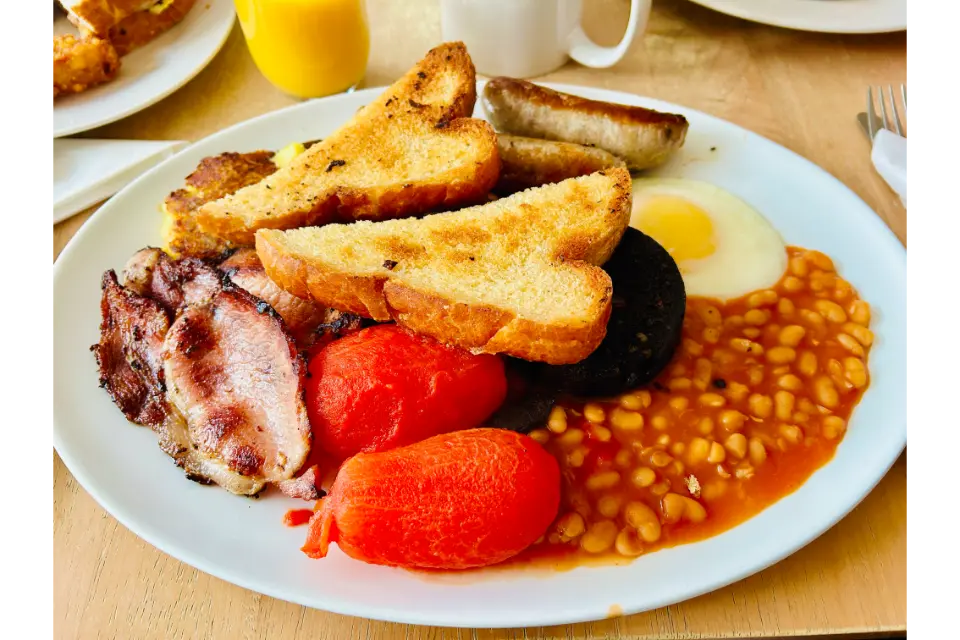
Black Pudding:
Despite being a sausage made out of congealed blood and oats, it’s considered a delicacy and part of traditional breakfasts. Widely available in Ireland, Scotland and England as one of the very Traditional British foods. Sadly, that is not the case in Singapore, where it is banned.
Love it or hate it, black pudding is an iconic and divisive British delicacy. This distinctive sausage gets its characteristic dark hue and robust flavor from the inclusion of fresh pig’s blood, combined with meat, fat, oatmeal or breadcrumbs, and aromatic seasonings like white pepper and nutmeg.
While the idea of congealed blood may turn some stomachs, black pudding has its roots in frugal, waste-nothing nose-to-tail traditions stretching back centuries. Originating in the rural villages of the Middle Ages, resourceful peasants aimed to use every part of the slaughtered animal. The cooked blood mixture not only provided vital iron and protein, but helped stretch minimal meat rations.
Today, varieties like the crumbly Stornoway pudding from Scotland and creamy Bury black puddings from Lancashire keep this humble, nourishing heritage alive. Whether savored for breakfast, baked into pies, or griddled up, black pudding remains a polarizing yet quintessential taste of Britain’s culinary past.
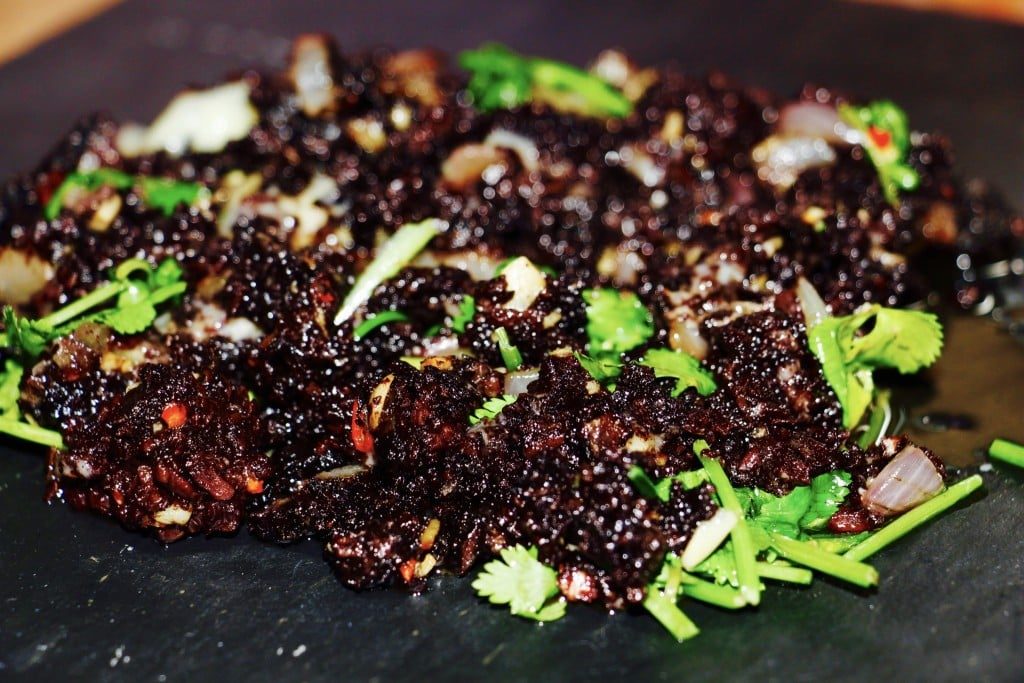
Yorkshire Pudding:
Despite the name, it’s not a dessert but a savoury dish made of eggs, flour, milk, and fat (lard). This is a no-brainer for a top 20 Famous British dishes, it’s a stand out for any roast dinner, and us also a hallowed skill to cook big risen puds. Sadly, I did not inherit that cooking gene from my Mum, as mine always turn out like flipping crepes.
Ask any Brit to name one of their most beloved national dishes and you’re likely to hear “Yorkshire Pudding” uttered with immense pride and nostalgia. This humble yet iconic baked delicacy has graced British tables for centuries, emerging from the frugal kitchens of Yorkshire County as a delicious way to stretch meagre portions of meat.
The basic batter of eggs, flour, and milk may seem simple, but it transforms into magical, crispy, golden pudding cups when baked at high heat in sizzling beef dripping. While originally consumed as a separate course with gravy and fillings, Yorkshire puddings eventually became standard accompaniments to a classic English Sunday roast.
Towering, bronzed puddings served fresh from the oven are torn into and eagerly soaked up the rich, meaty juices. From piled high and filled with roast beef and veggies to the tiny, oven-baked “puddin’s” served as appetizers, few dishes better exemplify Britain’s resourcefulness and undying love for hearty, comforting fare.
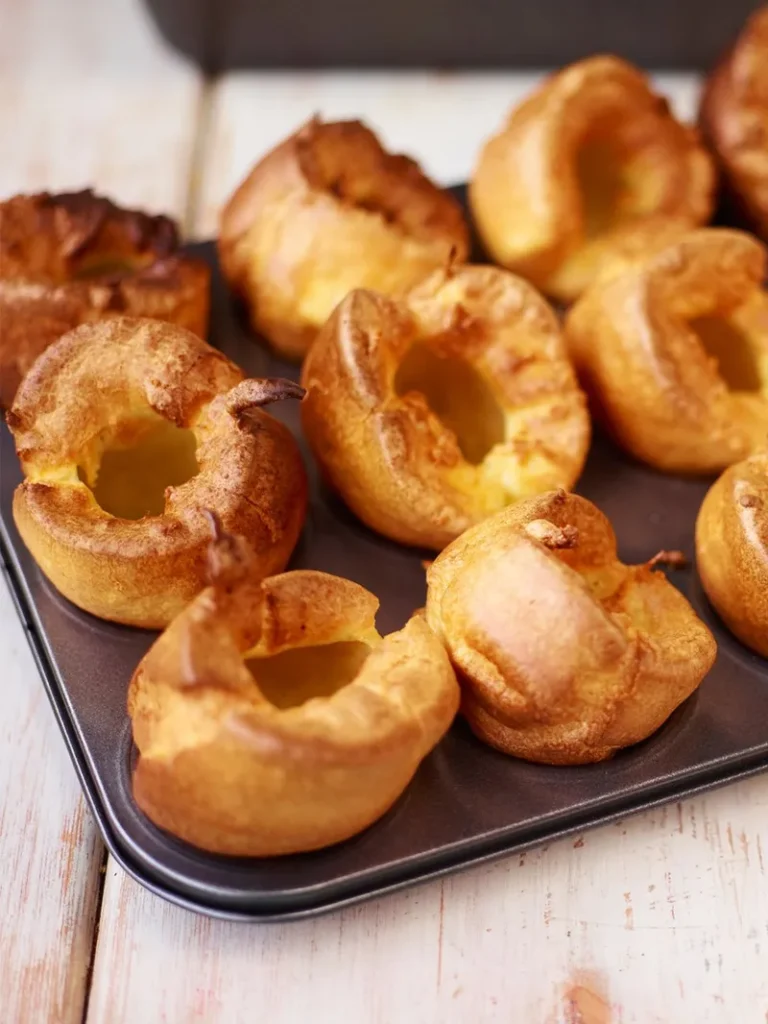
Photo courtesy of Jamie Oliver’s web site
Originating in the 19th century, this simple yet delicious dish features battered and fried fish served with crispy chips (fries), a staple in British fast food, and up there as the most famous of Traditional British foods.
It’s nearly impossible to think of British cuisine without the humble yet iconic fish and chips coming to mind. This unassumingly delicious pairing of hot, crispy deep-fried fish in batter and thick-cut chips (french fries) is so ingrained in the UK’s food culture and national identity that it was one of the few foods not rationed during World War II.
While the origins of frying pieces of fish and cutting potatoes are found across Europe, the modern construct we know and love today emerged in the 1860s from the working-class streets of London. Small businesses combining fried fish with the new-fangled concept of “chips” quickly became a cheap, portable meal for factory workers and families.
From the origins of basic Codfish coated in basic batter, today’s “fish and chip shops” showcase regional varieties like chunky barries from Edinburgh, beer-battered haddock in Yorkshire, or tender plaice fillets in crispy breadcrumbs down south. However prepared, this salty, crunchy, grease-laden British classic remains a cherished staple across all socioeconomic classes.
A little known fact though is that the fish itself is very healthy. That is not fried, but rather steamed inside the crispy outer shall of the batter. So if you discard the crunchy batter (you’re a heathen if you do) and just eat the fish, it is the most moist and perfectly cooked fillet of cod. But please diregard everything I just said!!!

A comfort food classic, made with minced lamb, mashed potatoes, gravy, and vegetables. Not to be confused with a Cottage Pie, which uses minced beef. Yes, I have eaten Shepherd’s Pie in restaurants and realised they’ve used beef mince. Whoopsy!!! So actually I would say both pies are Famous British dishes. My Nan’s and my Mum’s versions were most awesome, and I have so many happy memories of wolfing this dish down.
Shepherd’s pie is a true classic of British comfort food that has kept families warm and bellies full for centuries. This hearty dish consists of a savory base of ground lamb, cooked with aromatic vegetables and gravy, topped with creamy mashed potatoes that create a crunchy, golden-brown crust when baked. While its exact origins are murky, Shepherd’s pie emerged in the 1700s as an economical way for peasant families and shepherds to stretch leftover roasted meat scraps into a complete, nourishing meal.
Early versions were simple stuff – just the basics of meat and potatoes. But over time, clever cooks from Yorkshire to Sussex started enhancing the filling with the likes of Worcestershire sauce, ground lamb kidney, rosemary, or parsnips for extra heartiness. Today, shepherd’s pie remains a beloved staple in British households – a delicious legacy celebrating the nation’s talent for transforming humble ingredients into stick-to-your-ribs fare.
Whether topped with a dollop of HP Sauce or a sprinkle of sharp cheddar cheese, this rustic meat pie epitomizes the very best of England’s rich culinary heritage.
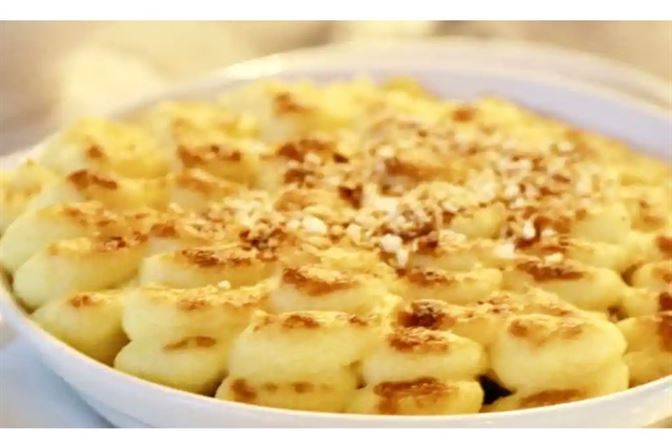
Sausages served with mashed potatoes and gravy, a classic British pub food.
Simple, hearty, and quintessentially British, bangers and mash is a classic dish that has satisfied appetites for generations. This humble pairing of plump pork sausages and a heaping mound of creamy, buttery mashed potatoes can be traced back to the frugal fare of England’s rural villages in the 1800s.
Affordable, filling sausages made from salt-cured pork and breadcrumbs were nicknamed “bangers” for their tendency to split open with a bang when fried. Smothered in a rich, meaty onion gravy alongside pillowy potatoes, it was the ideal stick-to-your-ribs meal for farmers and coal miners needing sustenance for long workdays.
While the bangers today are infinitely better quality and varied than their basic ancestors, the simple pleasures remain unchanged – piercing the crispy casing to release a juicy burst of seasoned meat, mopping up every last drop of savory gravy with clouds of fluffy spuds. Whether still a weeknight staple or elevated to pub grub, bangers and mash embodies Britain’s eternal love for uncompromisingly comforting food.

This dish is made from leftover potatoes and vegetables, often from a roast dinner, which are fried together until crispy. A belter of Traditional British foods. My Nan used to make this every Monday morning after a Sunday Roast with the leftovers.
Bubble and Squeak, an epic British dish, traces its roots back to the ingenuity of frugal cooks during the era of World War II rationing. Born out of necessity, this humble concoction was a clever way to repurpose leftover vegetables, typically potatoes and cabbage, by frying them together into a delightful patty.
The name itself, whimsical and onomatopoeic, is said to have originated from the sizzling and popping sounds emanated by the frying mixture. Despite its humble beginnings, Bubble and Squeak has endured as a beloved comfort food, a testament to the culinary resourcefulness of generations past and a delightful fusion of flavors that continues to grace British tables to this day.
You can bejazzle it with additional ingredients like a fried egg, fried bacon and so on – go crazy, you can’t go wrong.
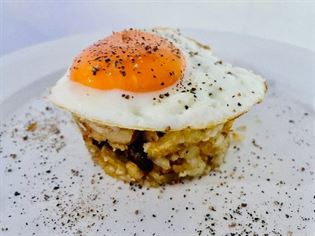
Spotted Dick:
A sweet dessert consisting of a dense sponge made with sugar, flour, and currants, often served with custard. One of the most famous of Traditional English desserts: no, this is not an STD.
Spotted Dick, a quintessentially British dessert, has a name that may raise eyebrows but a history deeply rooted in the culinary traditions of the British Isles. Originating in the 19th century, this delightful pudding was a staple in the diets of working-class families, renowned for its comforting and economical qualities. The “spotted” moniker refers to the plump raisins or currants that dot the steamed suet pudding, lending a delightful burst of sweetness to the otherwise plain batter.
Despite its peculiar name, which is believed to have evolved from the word “pudding” being corrupted over time, Spotted Dick has endured as a beloved treat, a heartwarming reminder of the ingenuity and resourcefulness that have long characterized British cuisine.
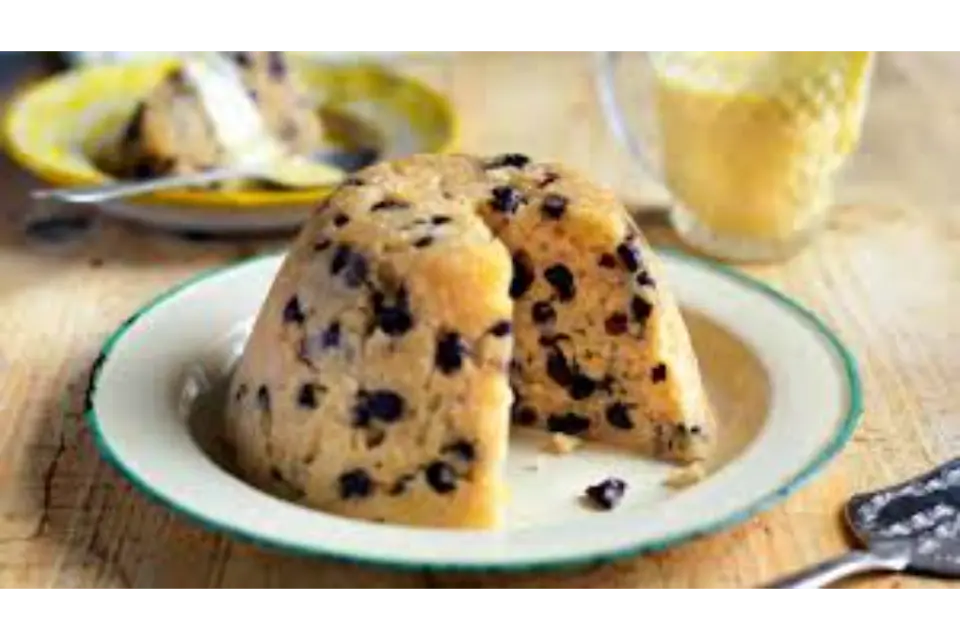
Photo courtesy of the BBC Food Web Site
A Scotch Egg is a soft-boiled egg wrapped in sausage meat, coated in bread crumbs and then deep-fried or baked. Yet another of the true classics of Traditional British foods. My Mum is a dab hand at cooking these, and I have to say I think I also inherited her Scotch Egg genes.
Scotch eggs are a true culinary marvel, combining the delightful flavors of a soft-boiled egg, savory sausage meat, and a crisp, golden bread crumb coating: WOOF!!! This portable, protein-packed snack has become a beloved staple in British cuisine, gracing picnic baskets, pub menus, and family gatherings alike.
The origins of this ingenious creation can be traced back to the affluent households of 19th-century England, where scotch eggs were a convenient and filling option for wealthy travelers embarking on long journeys by horse-drawn carriages.
While the exact inventor remains shrouded in mystery, several theories abound, including one that credits the humble beginnings of Scotch eggs to resourceful Yorkshire farmers seeking a means to preserve and prolong the shelf life of their eggs.
Regardless of its provenance, the scotch egg has transcended its aristocratic roots, becoming a cherished part of Britain’s culinary heritage. From the bustling markets of London to the quaint villages dotting the countryside, this portable delicacy continues to delight and nourish generations of food enthusiasts, a testament to the enduring appeal of simple yet ingenious culinary creations.
I, myself, won a cooking competition for Best Scotch Egg – and I won the non-Chef category with my Laab Gai Scotch Egg – which shows you how versatile this bad boy can be.
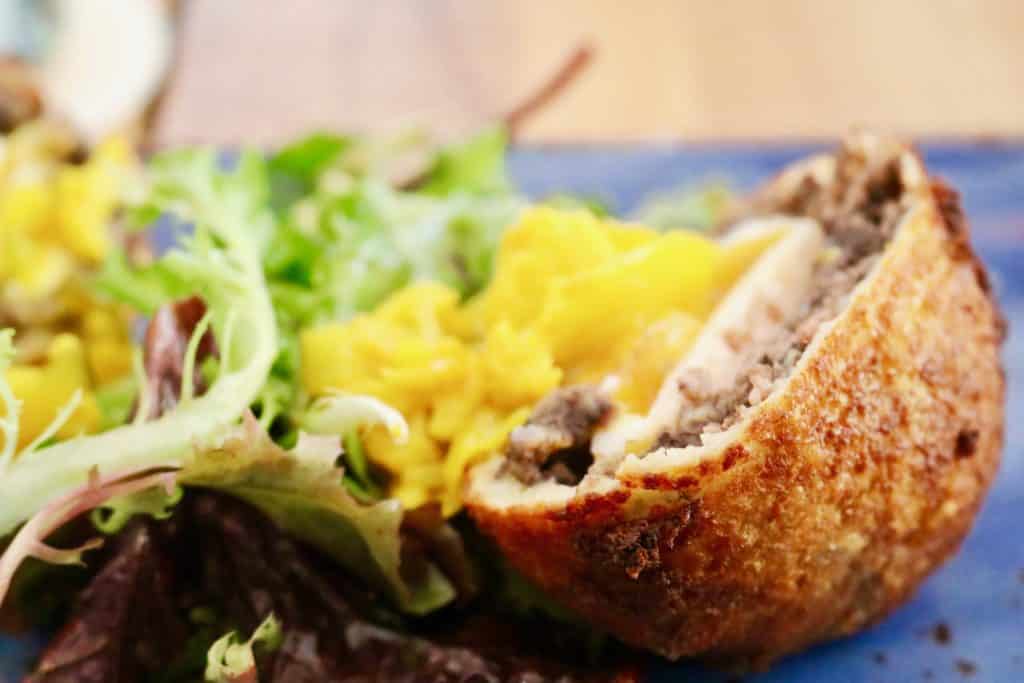
Cornish Pasty:
How could I do a top 20 Famous British dishes, and not have Cornish Pasties. Originally made to be a handy and hearty snack for Cornish coal miners, it’s a stable food now globally. What an export.
The Cornish pasty, a savory hand-pie filled with a delectable blend of beef, potatoes, swede, and onions, is a cherished culinary icon that has become synonymous with the rugged landscape and rich mining heritage of Cornwall, England. This portable and hearty meal dates back to the 13th century, when the wives and mothers of tin miners in the region crafted these robust pastries as a practical and nutritious lunch for their hard-working husbands and sons.
The pasty’s distinctive shape, with a thick, crimped edge along one side, was designed to serve as a handy grip, allowing miners to easily grasp and consume their meal without contaminating the filling with the traces of arsenic often present on their hands: how about that. I feel the same when I eat at McClowns.
This ingenious design, coupled with the satisfying combination of ingredients, made the Cornish pasty an enduring symbol of the region’s industrious spirit and culinary ingenuity. Today, this beloved pastry has achieved global recognition, with countless variations and adaptations, but the authentic Cornish pasty remains a source of immense pride for the people of Cornwall, a delicious testament to their resilience and resourcefulness.
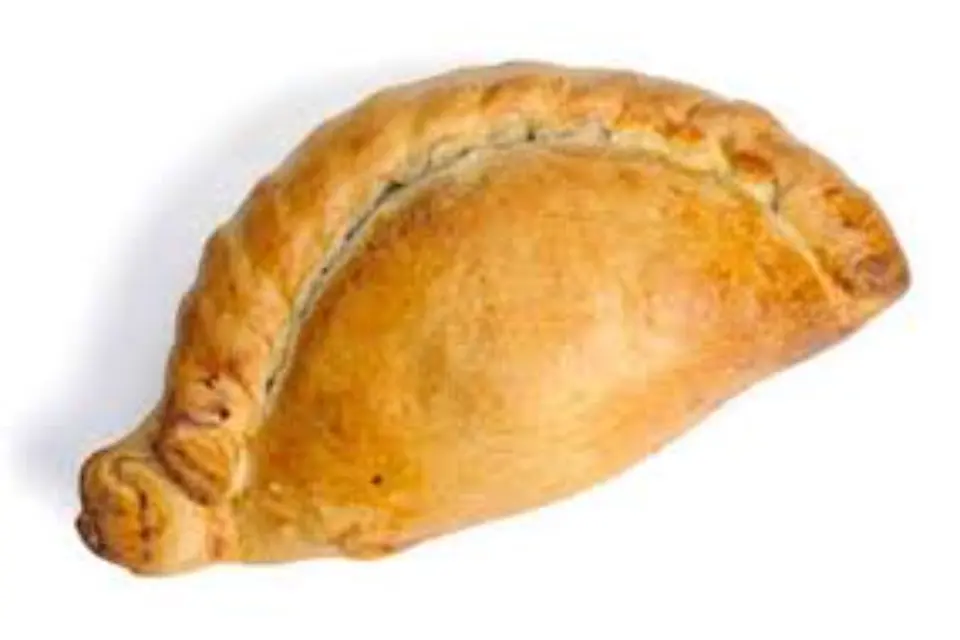
Photo courtesy of Cornish Pasty Association
Eton Mess:
A classic English dessert consisting of strawberries, broken meringue, and whipped heavy cream. Every Brit has surely had this epic of Traditional English desserts. It’s how we all fell in love with meringue.
Eton Mess, a delightfully whimsical and quintessentially British dessert, is a delectable medley of strawberries, meringue, and luscious cream. Despite its seemingly haphazard appearance, this sweet treat boasts a rich history that can be traced back to the prestigious Eton College, one of England’s most esteemed institutions of learning. According to culinary lore, the dessert was an accidental creation, born from a fortunate mishap at the college’s annual cricket match against the pupils of Harrow School.
Legend has it that during the match, a clumsy Eton cook or student inadvertently stumbled and dropped a meringue dessert, shattering the delicate confection into fragments that mingled with the fresh strawberries and cream intended as accompaniments.
Rather than discarding the mishap, the resourceful cook embraced the serendipitous combination, giving birth to the delightful Eton Mess. This fortuitous accident has since become a beloved tradition, gracing the tables of British households and evoking nostalgia for the carefree days of youth and the enduring spirit of resilience that has long characterized the nation’s culinary heritage.

Photo courtesy of BBC Good Food Guide Web Site
Beef Wellington: preparation of fillet steak coated with pâté and duxelles, is then wrapped in puff pastry and baked. Famed by the most excellent Chef Gordon Ramsay as the most famous of Famous British dishes is our Welly. Actually named after Wellington himself.
Few dishes are more emblematic of British culinary prowess than the illustrious Beef Wellington. This showstopping entrée of tender beef tenderloin coated in a decadent duxelle stuffing, wrapped in a cloak of flaky puff pastry, and baked to golden perfection has graced the tables of lords and ladies for centuries.
While its precise origins are murky, many historians credit the first beef wellington to the acclaimed 19th century chef Antonin Carême, who named the dish in honor of the Duke of Wellington’s victory at the Battle of Waterloo in 1815. Regardless of its beginnings, this culinary masterpiece epitomizes all that is beloved about British cooking – simple, premium ingredients elevated by refined technique into an indulgent, memorable feast for the senses.

Chicken Tikka Masala:
While the origins of this dish are disputed, it’s a popular dish in Britain, consisting of roasted marinated chicken chunks in a spiced curry sauce. How can a curry be one of our Traditional British foods? Well folks it is indeed.
Chicken tikka masala, a rich and aromatic curry dish featuring succulent chunks of marinated chicken enveloped in a creamy, tomato-based sauce, has become an iconic representation of Indian cuisine around the world. However, the true origins of this beloved dish are hotly debated, with multiple theories vying for recognition.
One widely accepted account traces its roots to the bustling city of Glasgow in the 1970s, where a resourceful Pakistani chef, faced with an unsatisfied customer’s complaint about dry chicken tikka, improvised by crafting a luscious tomato gravy to rejuvenate the dish.
This fortuitous fusion of traditional South Asian flavors and British culinary sensibilities proved to be a resounding success, swiftly spreading across the United Kingdom and eventually achieving global acclaim.
Another theory suggests that chicken tikka masala may have originated in the Punjab region of India and Pakistan, where the tandoori cooking tradition has thrived for centuries. Regardless of its precise origins, this rich and indulgent curry has transcended cultural boundaries, becoming a beloved staple in Indian restaurants worldwide and a testament to the enduring power of culinary innovation to unite diverse palates and traditions.
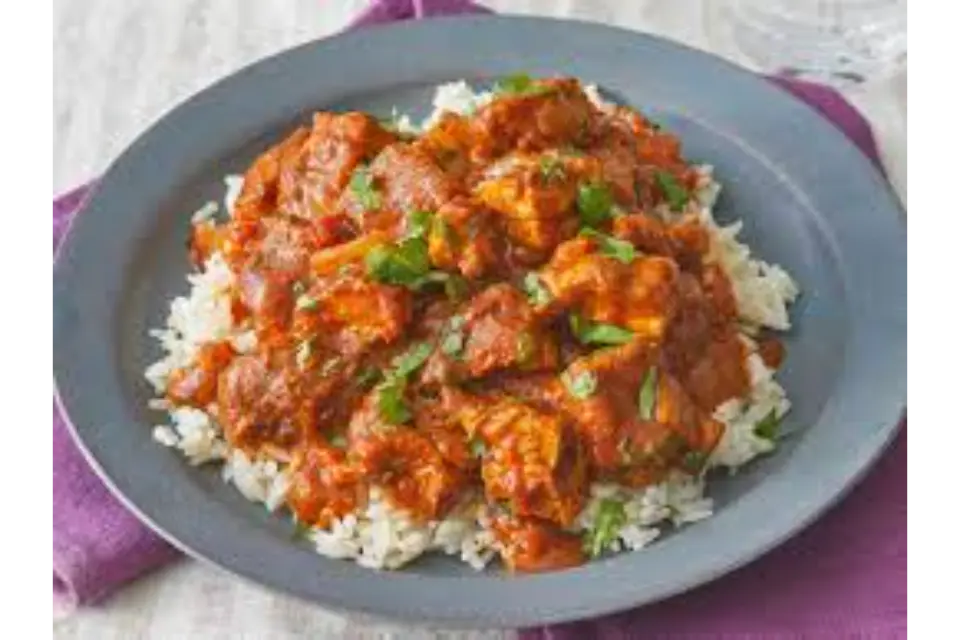
Photo courtesy of AllRecipes Web Site
This traditional British main meal is typically served on Sundays, consisting of roasted meat, roast potatoes, Yorkshire pudding, stuffing, vegetables, and gravy. WOOF!!! I miss my Nan’s and Mum’s Sunday Roasts, I would actually include their versions as Famous British dishes. They were both so damned good at cooking this.
The epitome of British cuisine is the English Sunday roast, a time-honored tradition that has graced British tables for centuries, its roots intertwined with the nation’s rich culinary heritage and social customs.
This hearty meal, typically featuring a succulent cut of roasted meat accompanied by an array of piping hot vegetables, crisp roasted potatoes, and a generous serving of savory gravy, traces its origins back to the lavish feasts of the wealthy aristocracy in the 15th century.
As the Sunday rest day emerged in the wake of the Protestant Reformation, this indulgent repast became a weekly ritual, bringing families together to savor the fruits of their labor and celebrate the simple pleasures of good food and company.
Over time, the English Sunday roast transcended its privileged beginnings, becoming a beloved institution that united households across social strata. From the humblest cottages to the grandest manors, the familiar aromas of roasting meat and simmering gravy would waft through the air, signaling a moment of respite and togetherness.
Today, this cherished culinary tradition continues to thrive, evolving with modern tastes and dietary preferences while retaining its essence as a comforting and convivial culinary experience that celebrates the enduring spirit of family dining.

Ploughman's Lunch:
A traditional British dish that typically includes cold, simple, and hearty ingredients, such as cheese, bread, pickles, and cold meats, usually served with apple. My Grandad’s favourite of Famous British dishes. He loved a Ploughman’s.
The ploughman’s lunch, an iconic British meal, is a celebration of humble ingredients and the enduring connection between the land and the table. Its origins can be traced back to the idyllic countryside of rural England, where hardworking farmers and agricultural laborers would pause for a midday repast.
Typically consisting of crusty bread, sharp cheese, pickled onions, and perhaps a wedge of tangy Cheshire or creamy Stilton, the ploughman’s lunch was a simple yet satisfying fare, designed to fuel the grueling physical exertions of those who tilled the soil.
As time passed, this rustic meal gained popularity beyond the confines of the fields, becoming a beloved dish in country inns and taverns. Innkeepers began to elevate the humble ploughman’s lunch, incorporating local charcuterie, fresh vegetables, and even a hearty dollop of chutney or pickle.
Today, this iconic dish has evolved into a canvas for regional specialties and culinary creativity, while still retaining its essence as a celebration of the land’s bounty and the enduring traditions of British cuisine.

Photo courtesy of Sandwich Tribunal Web SIte
A traditional British pie filled with diced beef, diced kidney (often of beef, lamb, or pork), fried onion, and brown gravy.
Steak and kidney pie, is a beloved staple of British cuisine, is a hearty and comforting embodiment of the nation’s culinary heritage. Its roots can be traced back to the humble kitchens of 19th-century England, where resourceful cooks sought to make the most of every available ingredient, including the often-overlooked offal from butchered animals.
By combining tender chunks of beef with nutrient-rich kidneys, encasing them in a rich gravy, and enveloping the savory filling with a buttery, flaky pastry crust, they created this absolutely unctuous beauty.
As steak and kidney pie gained popularity among the working classes, it soon found its way onto the menus of pubs and taverns across the country, becoming a beloved accompaniment to a pint of ale or a glass of robust red wine. Today, this iconic pie remains a beloved staple, its enduring appeal a testament to the ingenuity and resourcefulness of generations of British cooks, with additions like Guinness, Ale or even foie gras to up the ante.

Toad in the Hole:
This classic British dish consists of sausages in Yorkshire pudding batter, usually served with onion gravy and vegetables.
Toad in the hole, is a crazily named dish that delights both young and old alike, is a beloved part of British cuisine that has graced tables for generations. Despite its peculiar moniker, this hearty fare is a celebration of humble ingredients, combining savory sausages nestled snugly within a light and airy Yorkshire pudding batter. Its origins can be traced back to the 18th century, when resourceful cooks sought to stretch their rations by embedding pieces of meat or offal into a simple batter, creating a filling and economical meal that could feed an entire family.
As toad in the hole gained popularity among the working classes, it began to evolve, with sausages becoming the preferred choice of meat, lending their distinctive flavor and juices to the surrounding batter. Over time, this dish transcended its modest beginnings, becoming a beloved comfort food that graced the tables of households across social strata.
Today, toad in the hole remains a cherished culinary tradition, evoking nostalgia for simpler times and the enduring appeal of home-cooked fare. Whether served as a hearty supper or a comforting weekend brunch, this playfully named dish continues to delight generations of Britons.

Photo courtesy of BBC Good Food Web Site
Welsh Rarebit:
A dish made with a savoury sauce of melted cheese and various other ingredients served hot over slices of toasted bread. Yes, it’s basically cheese on toast.
Welsh rarebit is a delectable concoction of melted cheese, ale or beer, and savory seasonings. Its origins can be traced back to the humble taverns and inns of 18th-century Wales, where resourceful cooks sought to create a satisfying and affordable dish to accompany the local ales and beers.
By combining the rich, tangy flavors of aged cheddar with the malty complexity of ale, and infusing the mixture with a blend of mustard, Worcestershire sauce, and other piquant seasonings, they crafted a decadent and comforting treat that quickly became a local favorite.
As Welsh rarebit gained popularity across the region, it soon found its way onto the menus of pubs and taverns throughout Britain, where it became a beloved accompaniment to a pint of ale or a glass of robust red wine.
Over time, this indulgent dish has evolved, with variations incorporating additional ingredients such as bacon, onions, or even tomatoes, but its essence remains rooted in the rich tradition of Welsh culinary ingenuity. Today, Welsh rarebit continues to delight both traditionalists and modern palates alike, a comforting reminder of the simple pleasures that have long defined the nation’s culinary heritage.

Photo courtesy of BBC Good Food Guide
Victoria Sponge Cake:
Named after Queen Victoria, this cake is traditionally filled with jam and whipped cream, dusted on top with icing sugar. How cool to have your name used for one the top 20 Traditional English desserts. #BeProud Vic… I have great memories of my Nan and Mum making this, and I think I may have even made it myself when in the Cub Scouts.
The Victoria sponge cake, a quintessential British teatime treat, is a delightful embodiment of the nation. Its origins can be traced back to the reign of Queen Victoria herself, who is said to have favored this light and airy sponge cake filled with a luscious jam and lashings of fresh cream. As the story goes, one of the Queen’s household cooks created this simple yet indulgent confection, which quickly became a favorite among the royal family and their guests at Buckingham Palace. I like that a lot.
As the popularity of the Victoria sponge cake spread beyond the palace walls, it became a beloved staple in households across Britain, gracing countless afternoon tea services. The tender, golden sponge provides a delicate canvas for the sweetness of the jam and the rich, velvety cream.
This iconic cake remains a cherished tradition, with bakers of all skill levels proudly showcasing their own variations, from classic strawberry to inventive flavor combinations.

Photo courtesy of BBC Good Food Web Site
Scones with Jam and Clotted Cream:
Often part of a traditional cream tea, scones are served with jam and a dollop of clotted cream. A stunner of Traditional English desserts. As a family, we’d go to a pub in Wye, England and sit in the garden on a sunny day and wolf this down. I have such great memories of this true British Food icon and my family.
Scones, when paired with the indulgent accompaniments of jam and clotted cream, become such a well-known British delight that has graced afternoon tea services for generations. The origins of this beloved trio can be traced back to the pastoral landscapes of the British Isles, where resourceful cooks crafted simple, oven-baked scones from modest ingredients like flour, butter, and milk.
These tender, lightly sweetened rounds were the perfect plating for the vibrant flavors of fruit preserves and the luscious richness of clotted cream – a thick, velvety dairy confection born from the indulgent culinary traditions of the region’s dairy farms. Oh my, I am salivating.
As the ritual of afternoon tea gained popularity among the upper echelons of British society in the 19th century, the humble scone found its way onto the elegant tea tables of manor houses and royal palaces, often accompanied by the finest jams and creams.
This decadent pairing quickly became a cherished tradition, transcending social strata and capturing the hearts (and taste buds) of the nation. Today, the timeless combination of scones, jam, and clotted cream remains a beloved indulgence, evoking nostalgic memories of leisurely afternoons spent in good company.
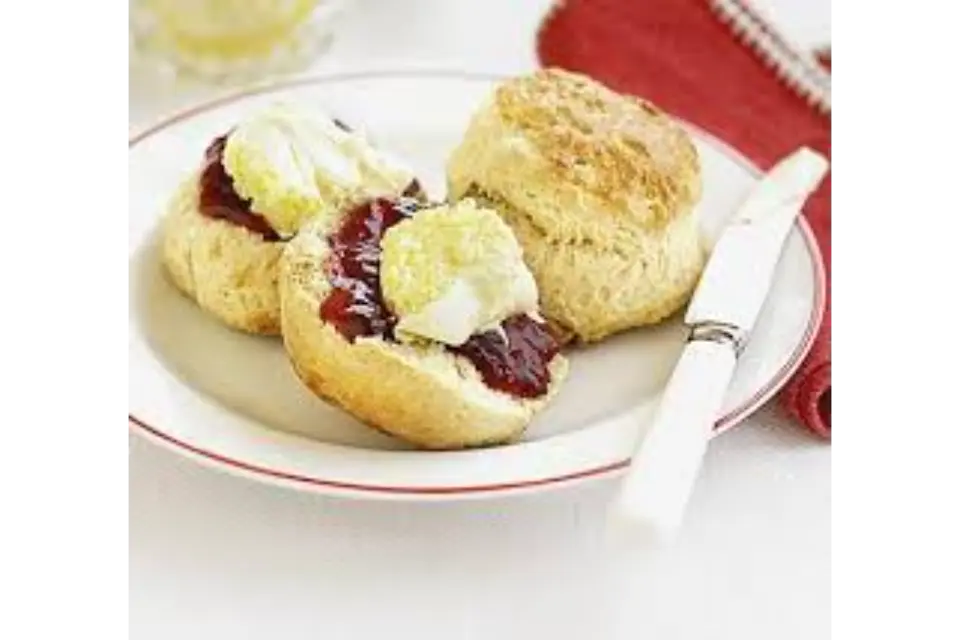
Photo courtesy of BBC Good Food Web Site
British food near me
If you’re looking for the Best British Food Near Me on your iPhone, how about we help you here with a short list of some of the best restaurants that probably do offer some of our Top 20 above? Sounds good? But, of course, it all depends where you are when you ask for British Food Near Me… So, in no particular order if your trying to get your Brit Fix, you wouldn’t go too far wrong with these.

ColBar Cafe: a non-air-conditioned local eatery reminiscent of the kampong restaurants of old (“kampong” means “village”) and hidden amongst black and whites in the bohemian Whitchurch Road, Colbar is a quaint and nostalgic hideaway, serving food that is a holdover from Singapore’s time under British rule. Colbar Eating House was the original name, opened by Mr and Mrs Lim 71 years ago. It’s in an ex-British army barracks site, and once served as a canteen for the huge military complex. Colbar stands for “colonial bar” in fact.
This is a family favourite. You simply must try the chicken curry and chips, and gammon steak with chips. It’s heavenly. Bring cash. Prepare to queue. And get your drinking face on, as they have a huge selection of bottled ales and ciders. ColBar Cafe Review HERE.

Gordon Ramsay’s first foray into Singapore’s dynamic dining scene, Bread Street Kitchen, has quickly become a British food fan favorite for its refined yet approachable British fare. The restaurant’s signature and iconic beef wellington makes an impressive showing, with its buttery puff pastry exterior giving way to a perfectly pink center of succulent beef tenderloin.
You need to book here. We love it here but have failed massively every time we try to walk-in. Breadstreet Kitchen Review HERE.

The Queen and Mangosteen, nestled within the bustling VivoCity mall, has created a devoted following for its authentic and flavorful British cuisine. The decor is infatuated with Union Jacks, British Bulldogs and so on, it’s like a British Street Party and some. Try the Scotch Eggs – simply epic!!! They serve quality British fare and have a regular Sunday Brunch too!!! Have it!!!

The English House has quickly become a beloved dining destination for those seeking an authentic British experience in the heart of Singapore. This charming restaurant, styled after a traditional English manor by acclaimed Michelin Chef: Marco Pierre White.
It offers a warm and inviting ambiance coupled with classic fare. Diners rave about the iconic fish and chips, with its crisp, beer-battered cod complemented by a heap of perfectly crisp fries. The Sunday roast is another must-try, featuring a succulent roasted prime rib served with all the trimmings like Yorkshire pudding, roasted vegetables, and rich gravy.
For a taste of quintessential British comfort food, the Shepherd’s pie is a fan favorite, with its delightfully cheesy mashed potato topping yielding to a robustly flavored filling of ground lamb and vegetables. The English House full review HERE.
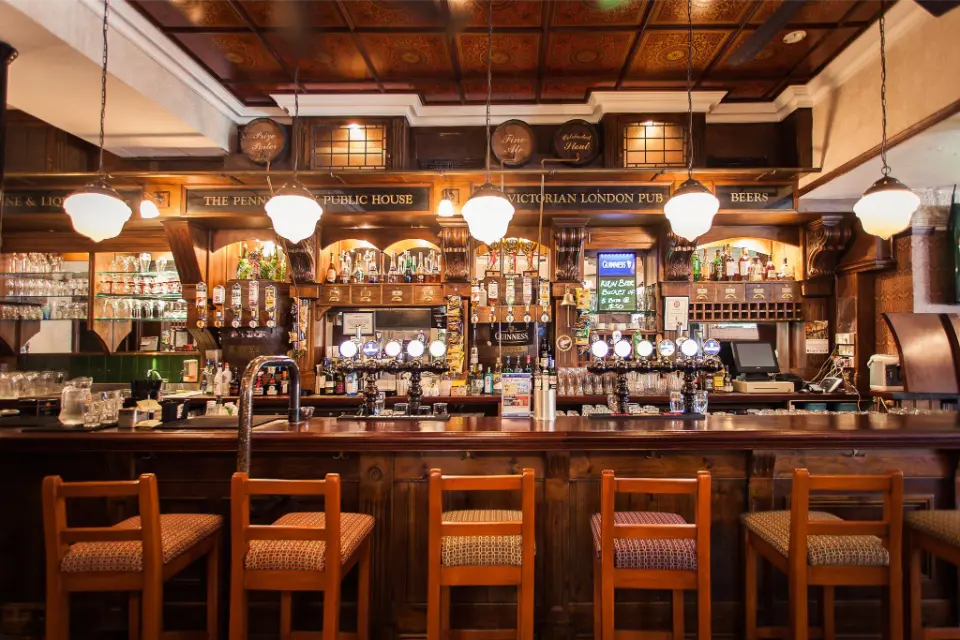
Tucked away along the picturesque Boat Quay, The Penny Black transports diners to a charming British pub setting. The restaurant’s classic dark wood accents, cozy booths, and plush leather seating evoke a warm, convivial atmosphere reminiscent of a traditional London public house. However, the real star is the mouthwatering menu brimming with elevated takes on beloved British dishes.
From the moment the iconic fish and chips arrive: a generous portion of fresh cod encased in a delightfully crisp beer batter alongside a heaping pile of chips (fries) with the perfect fluffy interior. It’s clear the kitchen excels at executing time-honoured British favorites with contemporary flair. The Scotch eggs, a whimsical riff replacing the typical sausage casing with haggis, are another standout, while the roast beef Yorkshire pudding remains a must-order for its tender slices of prime rib complemented by a gloriously puffy, golden-brown pudding.
With an impressive selection of ales, ciders, and craft cocktails perfectly suited for washing down the hearty fare, The Penny Black seamlessly blends cherished British culinary traditions with modern sensibilities.

Photo courtesy of HoneyKids Asia Web Site
Step through the doors of The British Club and you’re immediately enveloped in an air of sophisticated English elegance. Plush banquettes, dark wood panelling, and a distinguished gentlemen’s club ambience set an inviting tone.
However, the real draw is the menu overflowing with refined British classics executed with impeccable technique. From the delightfully flaky buttered crumpets and thick-cut marmalade to start, to the velvety smooth chicken liver parfait, each dish bursts with rich, comforting flavors.
For the main event, the Beef Wellington is the crowned jewel – a perfectly medium-rare tenderloin encased in a gloriously crisp and golden pastry that absolutely melts in your mouth. The servers ceremoniously carve each portion tableside, upholding the regal dining experience. Pair it with the heavenly truffle mashed potatoes and you’ll be patting your waistcoat in utter satisfaction.
The dessert trolley is equally impressive, tempting with an array of traditional English sweets like warm sticky toffee pudding and sherry trifle. With attentive service recalling Britain’s long history of hospitality, The British Club offers a luxurious journey through the United Kingdom’s iconic culinary heritage.
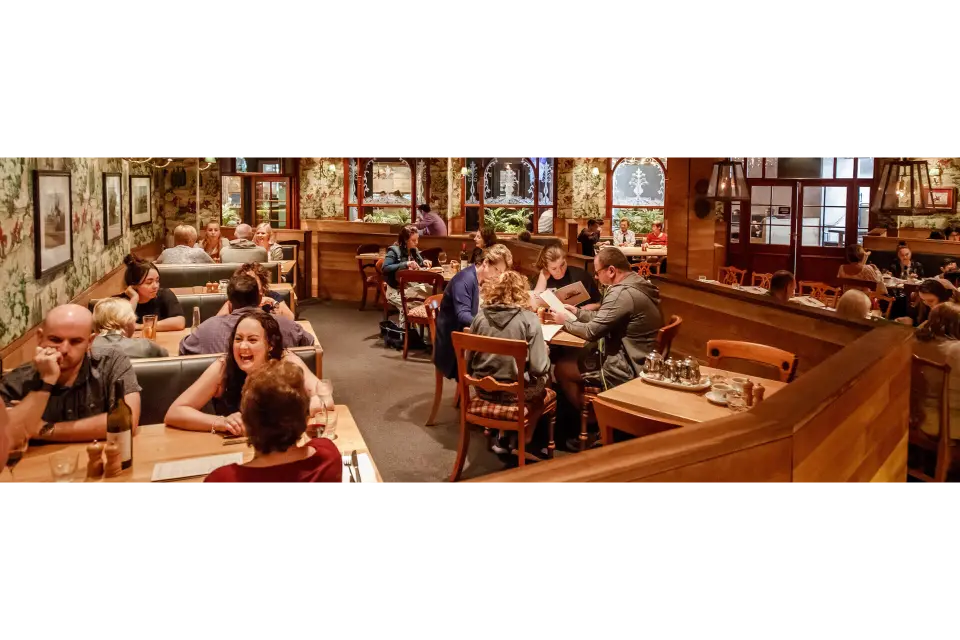
Photo courtesy of the Pig ‘n’ Whistle Facebook Site
Stepping into The Pig & Whistle feels like being transported directly to a cozy English pub right in the heart of Singapore. From the dark wood paneling and plaid accents to the shelves lined with Scotch whiskies, every detail evokes an authentic British ambiance.
The Sunday roast is an absolute must-try, with thick slices of succulent roast beef complemented by perfectly crisp Yorkshire puddings, vibrant green mint sauce, and rich beef gravy designed for copious bread dipping. Elsewhere on the menu, classics like the beer-battered fish and chips showcase deliciously light and flaky cod encased in a crispy golden hue.
The bangers and mash are also a hit, with juicy sausage links smothered in a deeply savory onion gravy alongside buttery mashed potatoes. For dessert, indulge in an iconic bread and butter pudding – velvety custard soaked into soft brioche with hints of vanilla and cinnamon. Coupled with a frosty pint of British ale, The Pig & Whistle delivers an authentic taste of the pub life from across the pond.
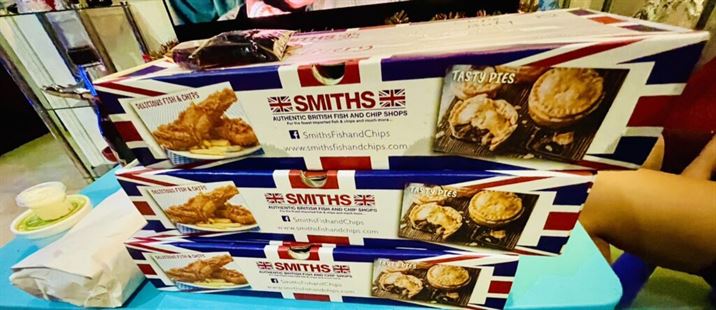
Smiths Fish and Chips: For an authentic taste of Britain’s most iconic dish, Smith’s Fish & Chips is a must-visit in Singapore. This unassuming joint transports diners straight to a classic London chippy with its no-frills decor of simple wood tables and the mouthwatering aroma of fresh fish frying. While the setting is straightforward, the food is decidedly upscale.
The star of their British Food is undoubtedly the cod – thick, flaky fillets dipped in an iconic beer batter that emerges an artistic crimson-tinged golden brown. Each bite delivers a contrasting crunch through the delicate exterior giving way to moist, flaky perfection. The chips (fries) also get the royal treatment – hand-cut, twice-fried, and tossed with a sprinkling of salt and vinegar for that quintessential British crispiness.
With piled-high portions, each plate of British Food is a delightfully indulgent homage to Britain’s working-class comfort food at its finest. Just don’t forget a pint of cold beer to wash it all down proper chippy-style: fish and chips | YUMMY!!!

Photo courtesy of Jaan by Kirk Westwood Web Site
Perched atop the iconic Swissôtel The Stamford, Jaan by Kirk Westaway offers a modern British dining experience that soars to new heights. The elegant interior combines warm wood tones with plush teal accents to create a sophisticated yet inviting ambiance. However, it’s the artfully crafted tasting menus that truly steal the show, allowing Chef Westaway’s innovative take on his UK heritage to shine.
Each exquisite course delivers a delightful interplay of quintessential British flavors reinterpreted with international influences and avant-garde techniques. The Orkney scallop with Beurre Noisette and Bramley apple is a standout – tender morsels accented by the rich brown butter and tart apple for a vibrant balance.
The Herdwick lamb arrivals cloaked in an herbaceous smokiness, accompanied by acidic pops of fermented green strawberry that cut through the succulence. Even classic desserts like the burnt cream with lavender honey transcend expectations through masterful execution.
With premium British ingredients sourced from trusted UK purveyors, every refined bite pays homage to Westaway’s culinary roots of British Food while elevating them to new gastronomic heights.
Step through the iconic polished teak revolving doors of Raffles Singapore and you’re immediately swept into an ambience of timeless colonial grandeur. The Grand Lobby sits at the very heart of this legendary heritage hotel, its lofty ceilings, stately pillars, and signature colonial fans transporting guests to the halcyon days of the British Empire. Yet amidst these stately surroundings, the true star is the authentic English afternoon tea experience.
From the classic three-tier stands brimming with assorted savory finger sandwiches and creamy scones with clotted cream and preserves, to mouthwatering sweets like English fruit cakes and dainty French pastries, every item exudes refinement. The extensive selection of premium loose leaf teas adds to the indulgence, with knowledgeable servers guiding you through options like the signature Singapore Breakfast blend.
As you sip and nibble accompanied by the mellifluous tunes of a live string quartet, you’ll understand why Raffles’ afternoon tea ritual has been a beloved tradition for over a century. This is an exquisite journey back to the privileged life of British high society, made all the more impressive by gracious service upholding Raffles’ esteemed heritage and British Food.
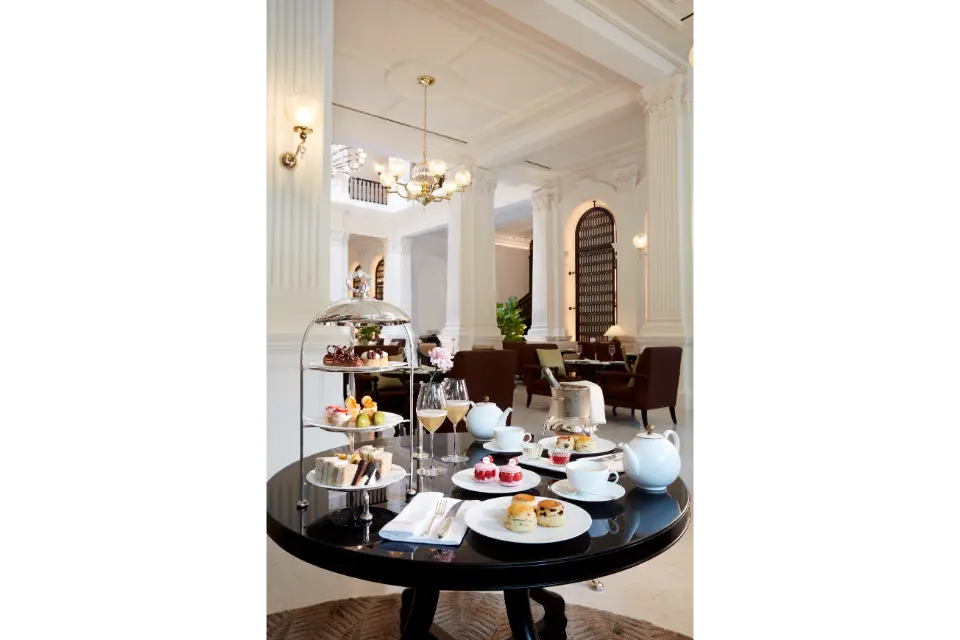
Photo courtesy of The Grand Lobby Raffles Web Site
British food recipes
Spencer and I are both Brits, we that run Isliferecipe.net, so we can turn a hand to cooking up some of the best British Food Recipes. To prove that point here you go: Best British Recipes from Islifearecipe.net



